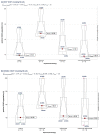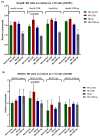Cyclooxygenase-2 Blockade Is Crucial to Restore Natural Killer Cell Activity before Anti-CTLA-4 Therapy against High-Grade Serous Ovarian Cancer
- PMID: 38201508
- PMCID: PMC10778357
- DOI: 10.3390/cancers16010080
Cyclooxygenase-2 Blockade Is Crucial to Restore Natural Killer Cell Activity before Anti-CTLA-4 Therapy against High-Grade Serous Ovarian Cancer
Abstract
Chronic inflammation influences the tumor immune microenvironment (TIME) in high-grade serous ovarian cancer (HGSOC). Specifically, cyclooxygenase-2 (COX-2) overexpression promotes cytotoxic T-lymphocyte-associated protein-4 (CTLA-4) expression. Notably, elevated COX-2 levels in the TIME have been associated with reduced response to anti-CTLA-4 immunotherapy. However, the precise impact of COX-2, encoded by PTGS2, on the immune profile remains unknown. To address this, we performed an integrated bioinformatics analysis using data from the HGSOC cohorts (TCGA-OV, n = 368; Australian cohort AOCS, n = 80; GSE26193, n = 62; and GSE30161, n = 45). Employing Gene Set Variation Analysis (GSVA), MIXTURE and Ecotyper cell deconvolution algorithms, we concluded that COX-2 was linked to immune cell ecosystems associated with shorter survival, cell dysfunction and lower NK cell effector cytotoxicity capacity. Next, we validated these results by characterizing circulating NK cells from HGSOC patients through flow cytometry and cytotoxic assays while undergoing COX-2 and CTLA-4 blockade. The blockade of COX-2 improved the cytotoxic capacity of NK cells against HGSOC cell lines. Our findings underscore the relevance of COX-2 in shaping the TIME and suggest its potential as a prognostic indicator and therapeutic target. Increased COX-2 expression may hamper the effectivity of immunotherapies that require NK cell effector function. These results provide a foundation for experimental validation and clinical trials investigating combined therapies targeting COX-2 and CTLA-4 in HGSOC.
Keywords: NK cells; cyclooxygenase-2; cytotoxic T-lymphocyte-associated protein-4; high-grade serious ovarian cancer; immunotherapy; tumor immune microenvironment.
Conflict of interest statement
The authors declare no conflict of interest related to this research.
Figures










Similar articles
-
Single-cell RNA sequencing reveals the change in cytotoxic NK/T cells, epithelial cells and myeloid cells of the tumor microenvironment of high-grade serous ovarian carcinoma.Discov Oncol. 2024 Sep 9;15(1):417. doi: 10.1007/s12672-024-01290-9. Discov Oncol. 2024. PMID: 39249551 Free PMC article.
-
Natural killer cells in the human lung tumor microenvironment display immune inhibitory functions.J Immunother Cancer. 2020 Oct;8(2):e001054. doi: 10.1136/jitc-2020-001054. J Immunother Cancer. 2020. PMID: 33067317 Free PMC article.
-
Deciphering the immune landscape dominated by cancer-associated fibroblasts to investigate their potential in indicating prognosis and guiding therapeutic regimens in high grade serous ovarian carcinoma.Front Immunol. 2022 Sep 2;13:940801. doi: 10.3389/fimmu.2022.940801. eCollection 2022. Front Immunol. 2022. PMID: 36119108 Free PMC article.
-
Naturally Killing the Silent Killer: NK Cell-Based Immunotherapy for Ovarian Cancer.Front Immunol. 2019 Aug 9;10:1782. doi: 10.3389/fimmu.2019.01782. eCollection 2019. Front Immunol. 2019. PMID: 31456796 Free PMC article. Review.
-
Natural Killer Cells: The Linchpin for Successful Cancer Immunotherapy.Front Immunol. 2021 Apr 28;12:679117. doi: 10.3389/fimmu.2021.679117. eCollection 2021. Front Immunol. 2021. PMID: 33995422 Free PMC article. Review.
Cited by
-
Promising new drugs and therapeutic approaches for treatment of ovarian cancer-targeting the hallmarks of cancer.BMC Med. 2025 Jan 6;23(1):10. doi: 10.1186/s12916-024-03826-w. BMC Med. 2025. PMID: 39762846 Free PMC article. Review.
-
The deregulation of arachidonic acid metabolism in ovarian cancer.Front Oncol. 2024 May 2;14:1381894. doi: 10.3389/fonc.2024.1381894. eCollection 2024. Front Oncol. 2024. PMID: 38764576 Free PMC article. Review.
-
Morphine Contributes to Epithelial-Mesenchymal Transition in Triple-Negative Breast Cancer Cells by Blocking COX-2 Methylation via Regulating the miR-23a-3p/DNMT3A Feedback.Cell Biochem Biophys. 2025 Apr 14. doi: 10.1007/s12013-025-01749-8. Online ahead of print. Cell Biochem Biophys. 2025. PMID: 40227561
-
Determination of high-grade serous ovarian cancer stem cell-based subtypes and prognostic model and identification of highly expressed VSIG4 and STAB1 in macrophages.J Ovarian Res. 2025 Jul 23;18(1):159. doi: 10.1186/s13048-025-01747-7. J Ovarian Res. 2025. PMID: 40702505 Free PMC article.
-
Visual analysis of ovarian cancer immunotherapy: a bibliometric analysis from 2010 to 2025.Front Med (Lausanne). 2025 Jul 11;12:1573512. doi: 10.3389/fmed.2025.1573512. eCollection 2025. Front Med (Lausanne). 2025. PMID: 40718421 Free PMC article. Review.
References
-
- Cheng Z., Mirza H., Ennis D.P., Smith P., Morrill Gavarró L., Sokota C., Giannone G., Goranova T., Bradley T., Piskorz A., et al. The Genomic Landscape of Early-Stage Ovarian High-Grade Serous Carcinoma. Clin. Cancer Res. Off. J. Am. Assoc. Cancer Res. 2022;28:2911–2922. doi: 10.1158/1078-0432.CCR-21-1643. - DOI - PMC - PubMed
-
- Pinto M.P., Balmaceda C., Bravo M.L., Kato S., Villarroel A., Owen G.I., Roa J.C., Cuello M.A., Ibañez C. Patient inflammatory status and CD4+/CD8+ intraepithelial tumor lymphocyte infiltration are predictors of outcomes in high-grade serous ovarian cancer. Gynecol. Oncol. 2018;151:10–17. doi: 10.1016/j.ygyno.2018.07.025. - DOI - PubMed
-
- Knutson K.L., Maurer M.J., Preston C.C., Moysich K.B., Goergen K., Hawthorne K.M., Cunningham J.M., Odunsi K., Hartmann L.C., Kalli K.R., et al. Regulatory T cells, inherited variation, and clinical outcome in epithelial ovarian cancer. Cancer Immunol. Immunother. CII. 2015;64:1495–1504. doi: 10.1007/s00262-015-1753-x. - DOI - PMC - PubMed
Grants and funding
LinkOut - more resources
Full Text Sources
Research Materials

